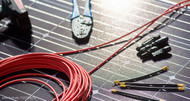SERIES VS PARALLEL WIRING SOLAR PANELS 101: PART 1
7th Nov 2022
With the increasing popularity and need to conserve energy, it is becoming easy to embrace more natural and eco-friendly methods of generating power, leading to rapid growth in the Solar Energy Industry. Solar panels and systems are quickly becoming more accessible for consumers, allowing end-users to utilize them to power their homes, appliances, and many other applications.
However, one of the most important factors when installing a solar panel system is to ensure that it is wired correctly, based on your specific needs. The main difference between wiring solar panels in Series vs. Parallel is that the voltage and amperage of the circuit will be affected. The energy production capacity of a solar panel is measured in watts, which can be achieved by multiplying the amps and its voltage. It is critical to find an appropriate balance of amps and voltage for the system to perform well, providing a better investment return.

Wiring Solar Panels in Series
Series wiring is used to specifically increase the voltage of the total solar panel system. The current travels along only one path, which means that the circuit current must pass through all loads. Since the Series circuit flows in a single line, any damage to one string point will affect the entire circuit.
For example, most older Christmas lights are wired in a Series circuit. If one bulb is affected, the rest of the string lights will go off. Fortunately, modern Christmas lights use Parallel wiring, eliminating the issue entirely.
The Series wiring is typically used when a charge controller needs more than 24 volts, or you have an inverter that is connected to the electrical grid.
Steps for Connecting Solar Panels in Series
The Series circuit is achieved by connecting the positive (+) terminal to the negative (-) terminal of each panel.
This will then leave you with one available negative (-) terminal and one available positive (+) terminal, which will be connected to the charge controller or inverter.
Wiring Solar Panels with Similar Characteristics in Series
In this scenario, the solar panels will be similar in power rating and type. The individual voltage from each panel is summed up, resulting in the total voltage of the system, while the amperage remains unchanged.
Example:
3 solar panels with a power rating of 6V/3A each will produce a total power output of 18V/3A when wired in Series.
Wiring Solar Panels of Different Voltages in Series
In this case, these solar panels have a similar current rating but with different voltages. When wired in Series, the amperage remains intact while the voltage increases.
Example:
3 solar panels with a rating of 5V/3A, 7V/3A, and 9V/3A will produce a power output of 21V/3A when wired in Series.
Wiring Solar Panels of Different Amperages in Series
In this scenario, because the solar panels have different voltage and amperage ratings, the voltage will still be added up, but the amperage will automatically adjust to the solar panel with the lowest value represented.
Example:
3 solar panels with a power rating of 3V/1A, 7V/3A, and 9V/5A will produce a total power output of 19V/1A when wired in Series, reducing its efficiency drastically.

Advantages of Solar Panels in Series
One of the many advantages of a Series configuration is that it is easy to transfer over long distances. Additionally, since the voltage is added up while the current remains the same, this allows you to save on installation costs, as you can get away with smaller gauged wires.
Disadvantages of Solar Panel Series Wiring
The downside to having a Series configuration is that the amperage remains constant and unchanged leading to reduced efficiency. Furthermore, when connecting panels with varying power ratings, the panel with the lowest amperage rating will determine the total current output of the system. Lastly, if one solar panel gets damaged or has connection issues, the entire system collapses in a Series configuration.
Final Thoughts
As we close out this blog, there is a time and place for wiring your solar panels in Series. As with everything, there are pros and cons as well as advantages and disadvantages to Series wiring. If Series wiring won’t work for your application, you could always parallel wire your system. In a follow-up blog, we will be talking about everything related to Parallel Wiring your Solar Panels.
